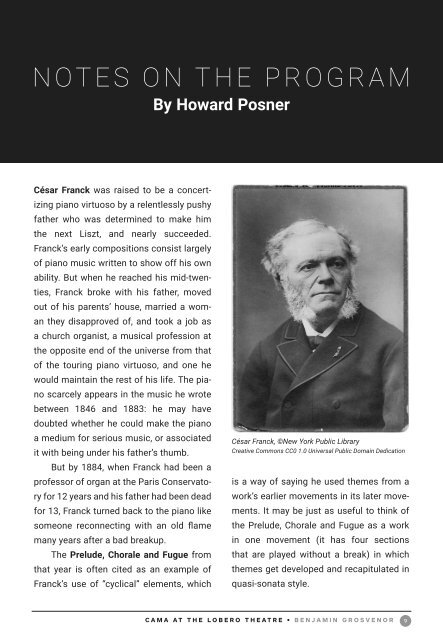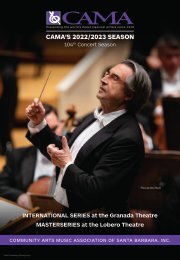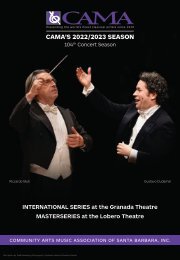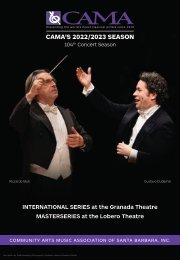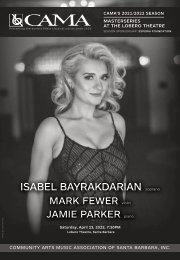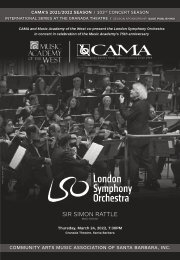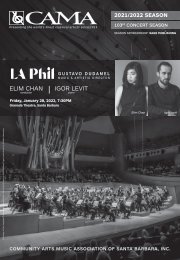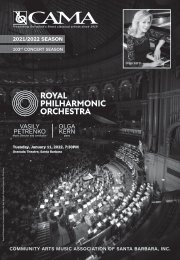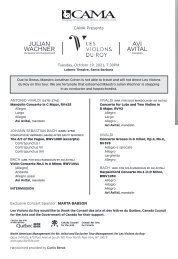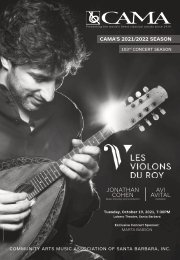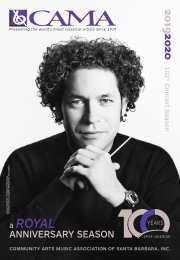CAMA's Masterseries Presents Benjamin Grosvenor, piano ⫽ Friday, March 18, 2022 ⫽ Lobero Theatre, Santa Barbara ⫽ 7:30PM
FRIDAY, MARCH 18, 2022, 7:30PM CAMA's Masterseries Presents BENJAMIN GROSVENOR, piano “His solo recitals recall an earlier generation of wizards of the piano.” —Financial Times British pianist Benjamin Grosvenor (b.1992) has been described as “the best pianist to come out of England in the last 50 years.” One only needs to listen to his playing to understand that the accolades are well deserved. Grosvenor’s promise was evident from a young age; he was the winner of the Keyboard Final of the 2004 BBC Young Musician Competition at the age of eleven, and was invited to perform with the BBC Symphony Orchestra at the Opening Night of the 2011 BBC Proms at London’s Royal Albert Hall at age nineteen. Turned away from performance by suddenly imposed pandemic precautions while already in Santa Barbara in March 2020, CAMA is delighted to welcome Benjamin Grosvenor back for his proper Santa Barbara and Masterseries debut! PROGRAM: FRANCK: Prélude, Chorale et Fugue, FWV 21 (1884) R. SCHUMANN: Kreisleriana, Op.16 ALBÉNIZ: Iberia, Book I RAVEL: Jeux d’eau RAVEL: La valse •
FRIDAY, MARCH 18, 2022, 7:30PM
CAMA's Masterseries Presents
BENJAMIN GROSVENOR, piano
“His solo recitals recall an earlier generation of wizards of the piano.” —Financial Times
British pianist Benjamin Grosvenor (b.1992) has been described as “the best pianist to come out of England in the last 50 years.” One only needs to listen to his playing to understand that the accolades are well deserved. Grosvenor’s promise was evident from a young age; he was the winner of the Keyboard Final of the 2004 BBC Young Musician Competition at the age of eleven, and was invited to perform with the BBC Symphony Orchestra at the Opening Night of the 2011 BBC Proms at London’s Royal Albert Hall at age nineteen. Turned away from performance by suddenly imposed pandemic precautions while already in Santa Barbara in March 2020, CAMA is delighted to welcome Benjamin Grosvenor back for his proper Santa Barbara and Masterseries debut!
PROGRAM:
FRANCK: Prélude, Chorale et Fugue, FWV 21 (1884)
R. SCHUMANN: Kreisleriana, Op.16
ALBÉNIZ: Iberia, Book I
RAVEL: Jeux d’eau
RAVEL: La valse
•
Create successful ePaper yourself
Turn your PDF publications into a flip-book with our unique Google optimized e-Paper software.
NOTES ON THE PROGRAM<br />
By Howard Posner<br />
César Franck was raised to be a concertizing<br />
piano virtuoso by a relentlessly pushy<br />
father who was determined to make him<br />
the next Liszt, and nearly succeeded.<br />
Franck’s early compositions consist largely<br />
of piano music written to show off his own<br />
ability. But when he reached his mid‐twenties,<br />
Franck broke with his father, moved<br />
out of his parents’ house, married a woman<br />
they disapproved of, and took a job as<br />
a church organist, a musical profession at<br />
the opposite end of the universe from that<br />
of the touring piano virtuoso, and one he<br />
would maintain the rest of his life. The piano<br />
scarcely appears in the music he wrote<br />
between 1846 and 1883: he may have<br />
doubted whether he could make the piano<br />
a medium for serious music, or associated<br />
it with being under his father’s thumb.<br />
But by 1884, when Franck had been a<br />
professor of organ at the Paris Conservatory<br />
for 12 years and his father had been dead<br />
for 13, Franck turned back to the piano like<br />
someone reconnecting with an old flame<br />
many years after a bad breakup.<br />
The Prelude, Chorale and Fugue from<br />
that year is often cited as an example of<br />
Franck’s use of “cyclical” elements, which<br />
César Franck, ©New York Public Library<br />
Creative Commons CC0 1.0 Universal Public Domain Dedication<br />
is a way of saying he used themes from a<br />
work’s earlier movements in its later movements.<br />
It may be just as useful to think of<br />
the Prelude, Chorale and Fugue as a work<br />
in one movement (it has four sections<br />
that are played without a break) in which<br />
themes get developed and recapitulated in<br />
quasi‐sonata style.<br />
CAMA AT THE LOBERO THEATRE • BENJAMIN GROSVENOR<br />
9


